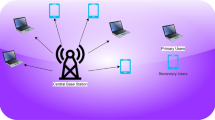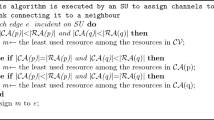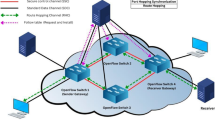Abstract
The security in cognitive radio networks (CRNs) has been attracting continuously growing attention due to the open and dynamic nature of cognitive radio architecture. In this paper, we propose new relay selection schemes to improve the physical layer security in CRNs. A trusted decode-and-forward relay is selected to help the secondary user (SU) transmission and improve the secrecy rate in the presence of multiple eavesdroppers and multiple primary users (PUs). The secrecy rate of the SU is characterized under both its own transmit power constraint as well as a set of interference power constraints imposed at each PU, in order to preserve its quality of service. The performance of the proposed schemes is analyzed in terms of the achievable secrecy rate and the intercept probability. Closed form expressions for the asymptotic intercept probability at high source-relays channel variances are also derived. Moreover, new derivations of some existing traditional schemes are presented and compared. The performance comparison of the proposed schemes with the schemes proposed in the literature reveals the superior of the proposed schemes.







Similar content being viewed by others
Notes
It should be noted that in [9] and [10] all relays are assumed to decode correctly , and the derived expressions of the intercept probability are considered exact . Our case is more general as we consider \(|{\mathcal{D}}| = N\) an asymptotic case. So, the derived expressions are considered asymptotic according to this assumption.
References
Akyildiz, I. F., Lee, W. Y., Vuran, M. C., & Mohanty, S. (2006). Next generation/dynamic spectrum access/cognitive radio wireless networks: A survey. Computer Networks, 50(13), 2127–2159.
Biglieri, E., Goldsmith, A. J., Greenstein, L. J., Mandayam, N. B., & Poor, H. V. (2013) Principles of cognitive radio. Cambridge: Cambridge University Press.
Shannon, C. E. (1949). Communication theory of secrecy systems. Bell System Technical Journal, 28(4), 656–715.
Wyner, A. D. (1975). The wire-tap channel. Bell System Technical Journal, 54(8), 1355–1387.
Barros, J., & Rodrigues, M. R. D. (2006, July). Secrecy capacity of wireless channels. In Proceedings of IEEE international symposium information theory (pp. 356–360).
Li, Z., Trappe, W., & Yates, R. (2007, March). Secret communication via multi-antenna transmission. In Proceedings of 41st conference on information sciences systems, Baltimore, MD.
Khisti, A., Womell, G., Wiesel, A., & Eldar, Y. (2007, June). On the Gaussian MIMO wiretap channel. In Proceedings of IEEE international symposium on information theory, Nice, France.
Oggier, F., & Hassibi, B. (2007). The secrecy capacity of the MIMO wiretap channel. IEEE Transactions on Information Theory, 57(8), 4961–4972.
Zou, Y., Wang, X., & Shen, W. (2013). Optimal relay selection for physical layer security in cooperative wireless networks. IEEE Journal on Selected Areas in Communications, 31(10), 2099–2111.
Zou, Y., Wang, X., & Shen, W. (2013, June). Intercept probability analysis of cooperative wireless networks with best relay selection in the presence of eavesdropping attack. In Proceedings of IEEE international conference on communicaitons (ICC 2013) (pp. 1–5).
Al-nahari, A., Krikidis, I., Ibrahim, A. S., Dessouky, M. I., & El-Samie, F. A. (2012). Relaying techniques for enhancing the physical layer secrecy in cooperative networks with multiple eavesdroppers. Transactions on Emerging Telecommunications Technologies (ETT), 25(4), 445–460.
Shu, Z., Qian, Y., & Ci, S. (2013). On physical layer security for cognitive radio networks. IEEE Networks, 27(3), 28–32.
Leon, O., Serrano, J. H., & Soriano, M. (2010). Securing cognitive radio networks. International Journal of Communications Systems, 23(5), 633–652.
El-Hajj, W., Safa, H., & Guizani, M. (2011). Survey of security issues in cognitive radio networks. Journal of Internet Technology, 12(2), 25–37.
Anand, S., & Chandramouli, R. (2008, May). On the secrecy capacity of fading cognitive wireless networks. In Proceedings IEEE CrownCom.
Pei, Y., Liang, Y., Zhang, L., Teh, K. C., & Li, K. H. (2010). Secure communication over MISO cognitive radio channels. IEEE Transactions on Wireless Communications, 9(4), 1494–1592.
Zou, Y., Wang, X., & Shen, W. (2013). Physical layer security with multiuser scheduling in cognitive radio networks. In IEEE Transactions on Communications, 61(12), 5103–5113.
Sakran, H., Nasr, O., Shokair, M., El-Rabaie, E., & El-Azm, A. (2012). Proposed relay selection scheme for physical layer security in cognitive radio networks. IET Communications, 6(16), 2676–2687.
Al-Jamali, M., Al-nahari, A., & Al-Khawlani, M. (2015). Relay selection scheme for improving the physical layer security in cognitive radio networks. In Proceedings of 23rd IEEE signal processing and communications applications, Malatya, 16–19 May 2015.
Krikidis, I. (2010). Opportunistic relay selection for cooperative networks with secrecy constraints. IET Communications, 4(15), 1787–1791.
Zou, Y., Wang, X., & Shen, W. (2013). Optimal relay selection for physical-layer security in cooperative wireless networks. IEEE Journal on Selected Areas in Communications, 31(10), 1787–1791.
Miller, S., & Childers, D. (2004). Probability and random processes with applications to signal processing and communications. San Diego: Elsevier Academic Press.
Author information
Authors and Affiliations
Corresponding author
Rights and permissions
About this article
Cite this article
Al-jamali, M., Al-nahari, A. & AlKhawlani, M. Relay selection schemes for secure transmission in cognitive radio networks. Wireless Netw 24, 911–923 (2018). https://doi.org/10.1007/s11276-016-1378-9
Published:
Issue Date:
DOI: https://doi.org/10.1007/s11276-016-1378-9




